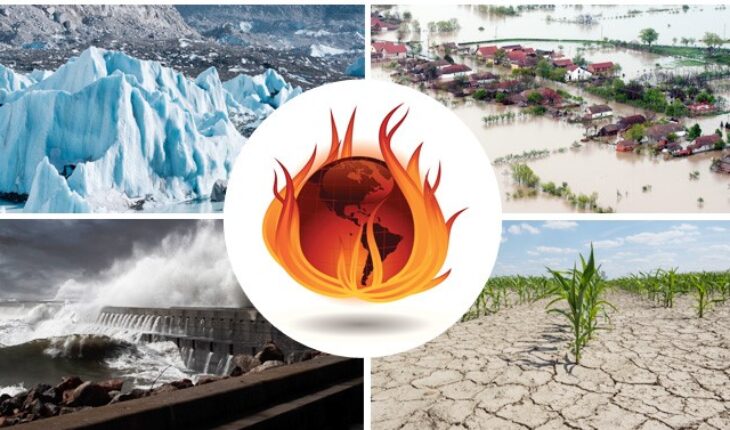
The climate is gradually getting warmer, that is, the temperature is increasing, for which there are many reasons, but pollution can be considered as its biggest factor. According to an estimate, within 10 to 15 years, the global temperature may increase by 1.5 °C, while by the year 2060 it may increase by 2 °C.
71 percent of the Earth’s surface is water and 29 percent is land. There are two ice sheets on Earth. The first covers most of Greenland, the world’s largest island, while the second covers the Antarctic continent. The ice sheet in the Antarctic covers about 14 million square kilometres. In other words, its area is equal to the combined area of the United States of America and Mexico. In such a situation, if the temperature of the earth increases, then the ice will melt and the sea level will rise, due to which many cities located in the coastal areas will be drowned. Due to this, many other side effects will also come to the fore, due to which there will be economic loss as well as there will be many dangers for human existence.
Overall impact on India
Today the negative effects of climate change are being seen in almost all parts of the country. Himalayas and coastal areas in the north and east, coastal areas in the south and west and all parts of central India are affected by it. According to the latest report of the Inter-Governmental Committee (IPCC) of the United Nations, due to climate change, problems like increase in rainfall, floods, droughts, landslides, and land erosion will arise here due to India’s climate being monsoon. Weather patterns will also change. There will be a feeling of cold in summer and of heat in winter.
Increase in flood frequency
According to an estimate, in the coming decades, about 35 million people living in coastal areas in India will have to face floods. The population living on the banks of both the Ganga and Brahmaputra rivers may have to face more floods. Other cities situated on the banks of the river will also be affected by this. We have been battling this problem for years. According to the Central Water Commission, from 1953 to 2017, more than 1 lakh people have died in India only due to floods. Due to floods, the quality of water will also decline and there will be a huge shortage in potable water.
Diseases will increase
Many people will die due to diseases like cholera, gastroenteritis and hepatitis in areas affected by excessive rains or floods. According to a World Bank report, 20 percent of the deaths due to floods and flood-borne diseases in the world occur only in India.
Water crisis will deepen
40 percent of India’s population will face water crisis by 2050. This estimate is not at all exaggerated, because at present about 33 percent of the people in the country are facing the problem of water crisis. According to the United Nations, by the year 2025, two-thirds of the world’s population will face the problem of water crisis. Due to lack of water, by the year 2045, about 13 crore people will have to leave their homes and villages. According to the international organization “Water Aid”, by the year 2030, water will be finished in 21 cities of the world. By the year 2040, there will be no drinking water in 33 countries of the world including India.
Reduction in crop production
The consequences of climate change are being seen in India for the past several years. Every year, due to climate change, either crops are not produced in lakhs of hectares of land, or the expected crops are not produced, due to which there is a shortage of food grains in the country. On one hand, there is economic loss due to reduction in the yield of crops and on the other hand, due to not getting enough food, the government has to spend huge amount on the treatment of sick people and people are also becoming victims of death.
According to the data available on the website of the National Disaster Management Authority, due to climate change, farming could not be done or expected production not seen on 47.13 lakh hectares of land in the financial year (FY) 2009-10. Similarly, in the FY 2010-11, farming could not be done or expected production not seen on 47.13 lakh hectares of land. In the financial year, 2016-17, it was 25.49 lakh hectare land, whereas in FY 2017-18, it was 47.44 lakh hectare land and in FY 2018-19, it was 17.01 lakh hectare land. In an average, the quantity of land is mounting.
Due to the reduction in crop production, there is a possibility of a huge increase in the price of cereals, which can have a negative impact on food security and economic growth. In the coming years, due to the increase in sea level and water crisis, the agricultural sector will be adversely affected. The production of wheat, pulses, coarse grains etc., in the country may decrease by about 9 percent by 2050. The increase in carbon emissions could reduce maize production in southern India by up to 17 percent.
Monetary Loss
We cannot quantify exact monetary loss due to be climate change. However, we can draw roughly sketch of it. Agriculture in India is still dependent on the monsoon. Therefore, due to climate change, when there will be flood or drought or if the production of crops will be adversely affected due to changing weather, then they will have a direct impact on agriculture. About 70 percent of the country’s population still lives in villages and the agriculture sector contributes about 14 percent to India’s gross domestic product (GDP). Of India’s approximately 121 crore population, 83.3 crore live in rural areas, while 37.7 crore live in urban areas. In such a situation, the rural economy can be destroyed by climate change. Some big industries also get their raw material from agriculture. Like jute, sugarcane, mustard, potato etc. In such a situation, it would be appropriate to say that the development of the country can get a big blow due to climate change.
Who is responsible?
The question is bound to arise, when all countries know that climate change can wipe out human existence. Therefore, it is the collective responsibility of all countries to work together to reduce this menace. The countries which are leading in spreading pollution should take further action with responsibility in this regard. India was ranked 8th in the Climate Change Performance Index in the year 2023, while other developed countries including China were far ahead in carbon emissions.
Initiative for solution
Recently, in the Russian city of Glasgow, India urged the developed countries of the world to create a special fund to deal with the effects of climate change, but the expected progress could not be made in the matter.
Conclusion
To solve the problem, India has taken the initiative to create a global fund, which can be considered very important, because this danger can be reduced to some extent only by reducing carbon emissions and with the help of money. Since the developed countries are also rich and technically capable, therefore, they should play an effective role in dealing with this problem.
Satish Singh, Mumbai Based Senior Columnist, views are personal





